Bougainvillea In Pots: Essential Care & Growing Tips
We love bougainvillea plants growing in the garden, but did you know it does well in containers too? If you’re looking for a colorful, long-lasting container plant, stop the search here. This is all about bougainvillea in pots, including care and growing tips and things to consider to keep yours healthy and flowering away.
A healthy plant puts out those big shows of color. All this information I’m sharing is what I’ve learned over eighteen years of growing bougainvillea in two different climate zones, zone 9a and zone 10a.
If you want to try growing bougainvillea in cold climates and bring it indoors for the winter, growing it in a lightweight pot is a good idea. I’ve only grown bougainvillea in pots outdoors year-round, so that’s what this post is about.
Bougainvillea in Pots: Care & Growing Tips
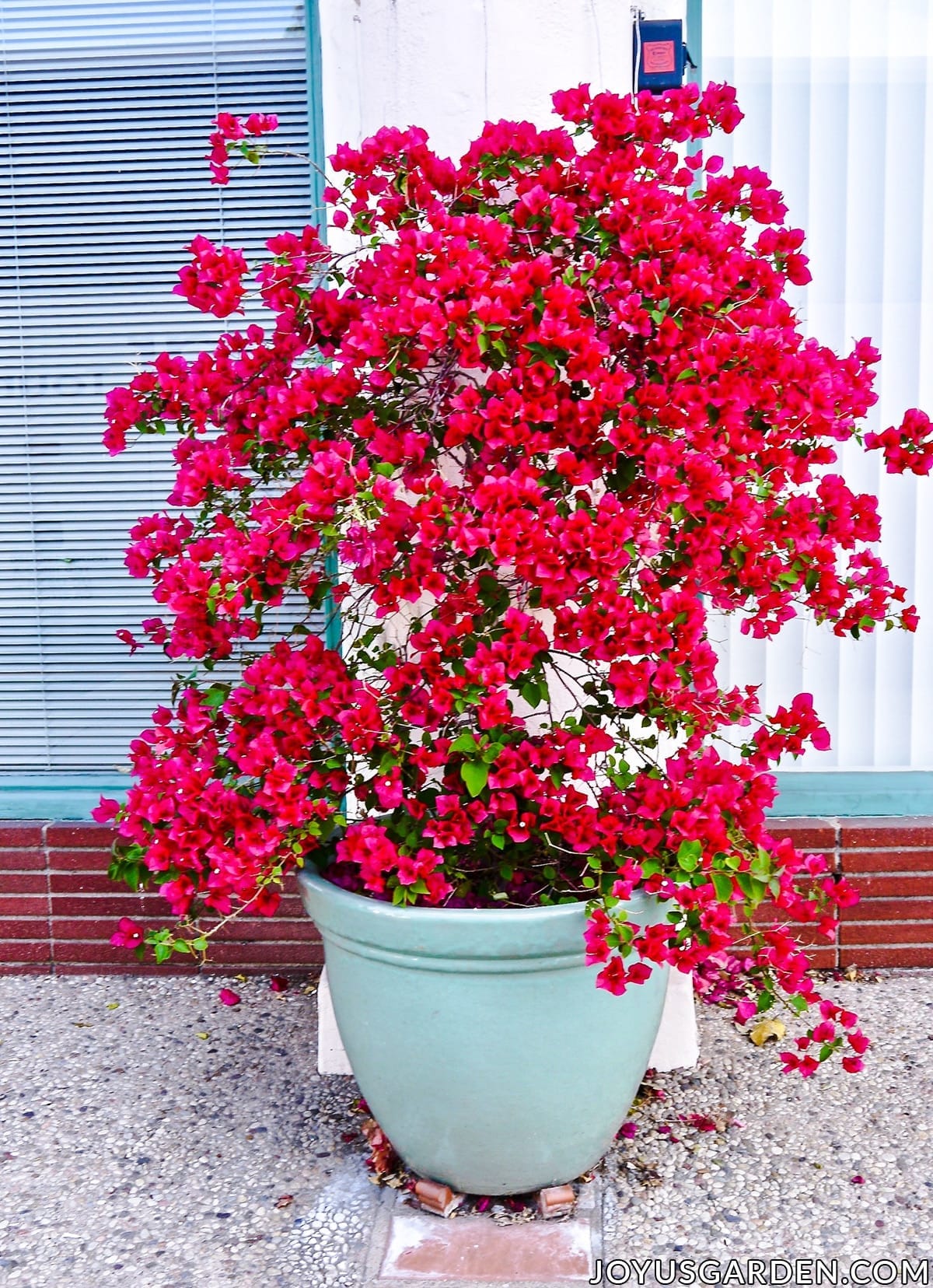
Bougainvillea Sun Requirements
Whether growing in a pot or the garden, Bougainvillea needs at least six hours of direct sunlight daily. This ensures an abundance of flowering and keeps the plant looking good.
When it doesn’t get enough sun, the flowering will be lackluster, and the plant will look thin and leggy. So, bougainvilleas tolerate part sun but won’t look as good as when growing in full sun. If your bougie isn’t flowering, it could very well be due to a lack of sun.
Bougainvillea also loves the heat, and even here in the Sonoran Desert where I live, it flowers throughout the intense heat of our sunny summers.
Hardiness
Bougainvillea, a tropical plant, is grown in USDA hardiness zones 9a – 11. It doesn’t like winter temperatures below 28-30 degrees Fahrenheit, especially not for a prolonged period. One or two random nights around or just below freezing will be okay, but three or four consecutive periods could be trouble.
Not sure what zone you’re in? Find your USDA hardiness zone here by inputting your zip code at the top.
Older, established bougainvilleas can withstand a freeze much better than newly planted ones.
Many varieties will lose part or all of their leaves in climates with winters on the cooler end of the spectrum. Some of the foliage from the previous season can remain on the plant and eventually falls off as new growth appears in spring.
If you live in a climate where bougainvillea is borderline zone hardy, planting it against a warm wall or in a corner against the house will help. Remember, this is one plant that loves sun and heat!
This is one area where bougainvillea’s size does matter. It’s much easier to protect a low-growing bougainvillea in a pot with a covering like a sheet or a freeze cloth than one that’s 15′ tall.
I’m in borderline zone 9a. I covered my “Blueberry Ice” growing in a pot six or seven nights this past winter with a sheet, whereas my other established bougainvilleas are too big to cover.
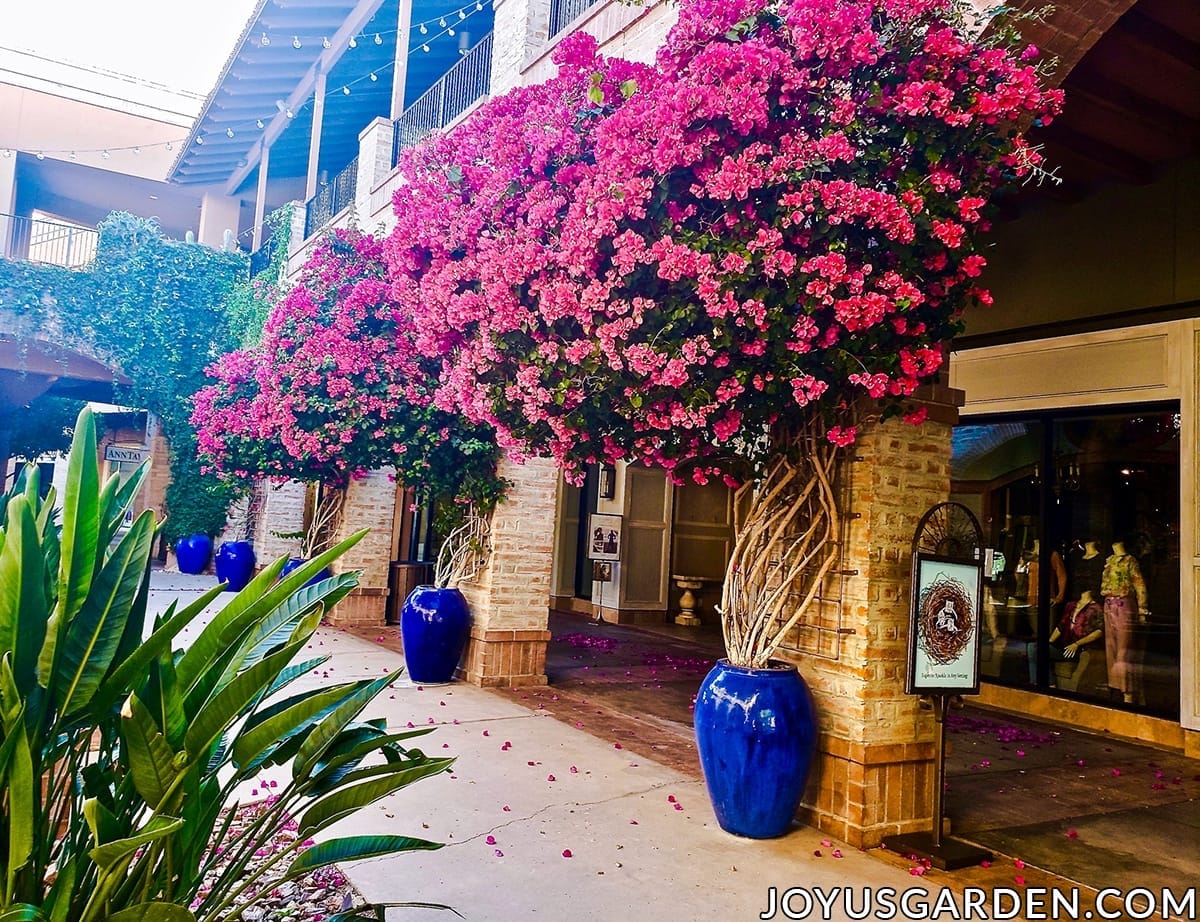
Watering Bougainvillea In Pots
How often to water bougainvillea in pots? That’s the big question, and the answer is: I don’t have one for you. The watering frequency is different in different climate zones and depends on the age of the plant, container size, and soil composition.
Bougainvillea growing in pots does best with regular watering, especially during the active growing season. Here in Tucson, I water mine thoroughly once a week in the hot months. If we’re having an excessive heat spell with a week’s worth of temps above 105F, I might water it twice a week if it’s looking stressed.
In the winter, it’s more like every 2 – 3 weeks or so. My bougainvillea in a pot is still newly planted, so in future winters, I’ll probably water it every three weeks.
On the coast of Southern California, where I lived (Santa Barbara), it was more like every two weeks or so in summer. The mornings were often foggy and cool, which meant less watering. Depending on the rain situation, maybe every 4-5 weeks in the winter.
Age plays a factor. Give your container bougainvilleas regular water when establishing (the first few years). Just be sure to keep your eye on one which is newly planted. When the top 2-3 inches of soil have dried out, you want to water an establishing bougainvillea.
Bougainvillea is more drought-tolerant once it’s established. It prefers good, deep waterings rather than frequent shallow ones.
One thing to know about watering and growing bougainvillea in pots is that drainage holes are necessary. This factor ensures excellent drainage and allows excess water to flow out, preventing root rot.
Bougainvillea’s subject to a few root rots, so don’t over-water. This is where soil comes into play also – it should be well-drained and aerated.
You’ll have to water the pot more often if it is smaller. You’ll have to water the plant less often if it is older. If the temps are higher, you’ll have to water more often. In the winter, you’ll water less often. If your plant is newly planted, water more often. Those are just a few variables to consider!
Do you have questions about growing this popular landscape plant? We answer your Questions About Bougainvillea Care here.
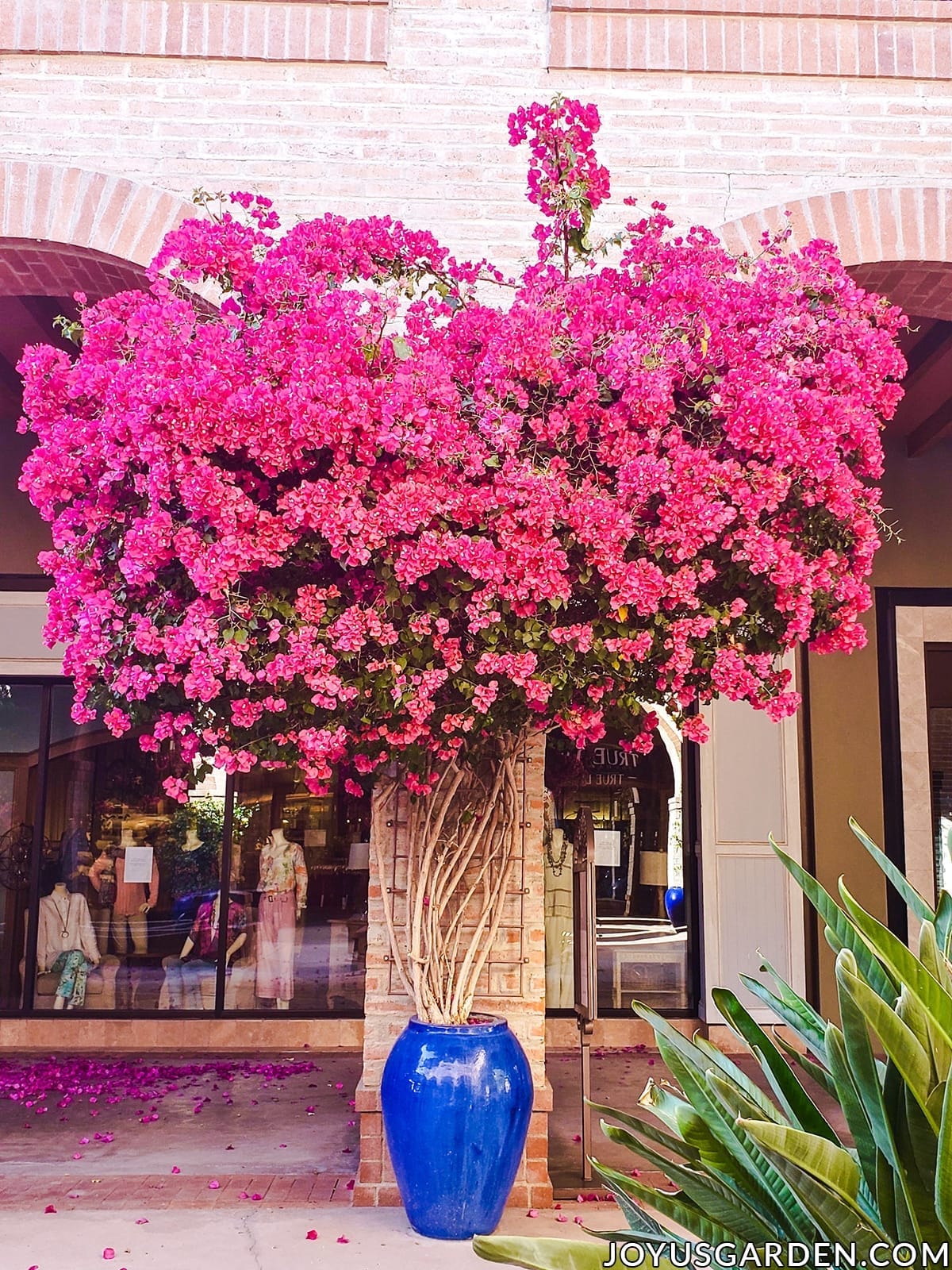
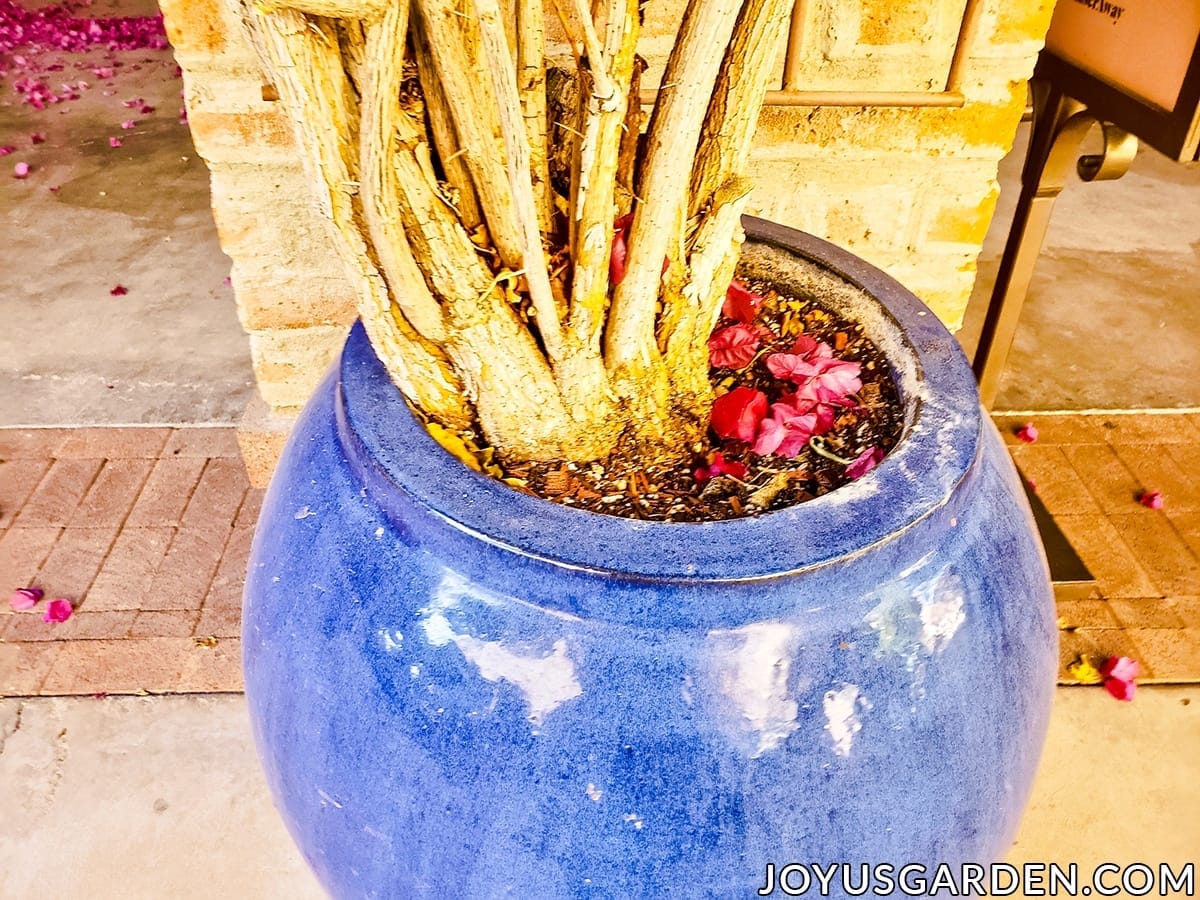
Feeding/Fertilizing Bougainvillea In Pots
I’ve never fertilized any bougainvilleas when planting or as part of care and maintenance.
In April, I fed my “Blueberry Ice” with a 1″ layer of worm compost and a 2″ layer of compost over that. Not only does this top dressing combo nourish the plant, but it also helps to hold a bit of moisture.
I used to work at a nursery in Berkeley, CA, where one of the growers recommended fertilizing bougainvillea with palm and hibiscus food. This fertilizer formulated for bougainvilleas is highly rated too. Whatever you use, follow the directions on the box. An application once or twice a year during the growing season (beginning of spring and/or mid-summer) will be just fine.
Pests
These are the pests I’m familiar with which can bother bougainvillea:
Orange aphids can be an issue on the tender new growth of bougainvilleas in early spring. I spray them off with a gentle blast of the garden hose, which does the trick.
The bougainvillea looper caterpillar has been an issue with my bougies in both here in Arizona and when I lived in California. They’re green, brown, or greenish-yellow and tiny – maybe 1″ long.
These loopers feed at night and chomp mainly on the leaves. I leave them be, and eventually, they go away. Because my bougainvilleas shed most of their leaves towards the end of winter, it’s not that big a deal for me.
In mid-summer two years ago, leafcutter bees enjoyed one of my bougainvilleas, but they eventually moved on. They’re fast-moving and are valuable pollinators for many plants. For this reason, I also leave them be. We need our pollinators!
Lastly, scale insects like mealybugs and hard-shell scales are also known to be problematic.
This most likely won’t be an issue for you, but it is for me, so I’ll mention it here. I bought my Bougainvillea Blueberry Ice up in Phoenix at the end of August and left it on my covered side porch. I planned to plant it in the tall blue pot in September once the weather cooled.
One morning, I looked out the sliding glass doors, and packrats had pruned my full, beautifully shaped bougainvillea. They’re common here in the Sonoran Desert, and I didn’t appreciate them hacking away at my bougie, especially because they did such a bad job of “pruning.” Bougainvilleas grow quickly once the weather warms, and the plant grew back beautifully and had a decent shape by mid-summer.
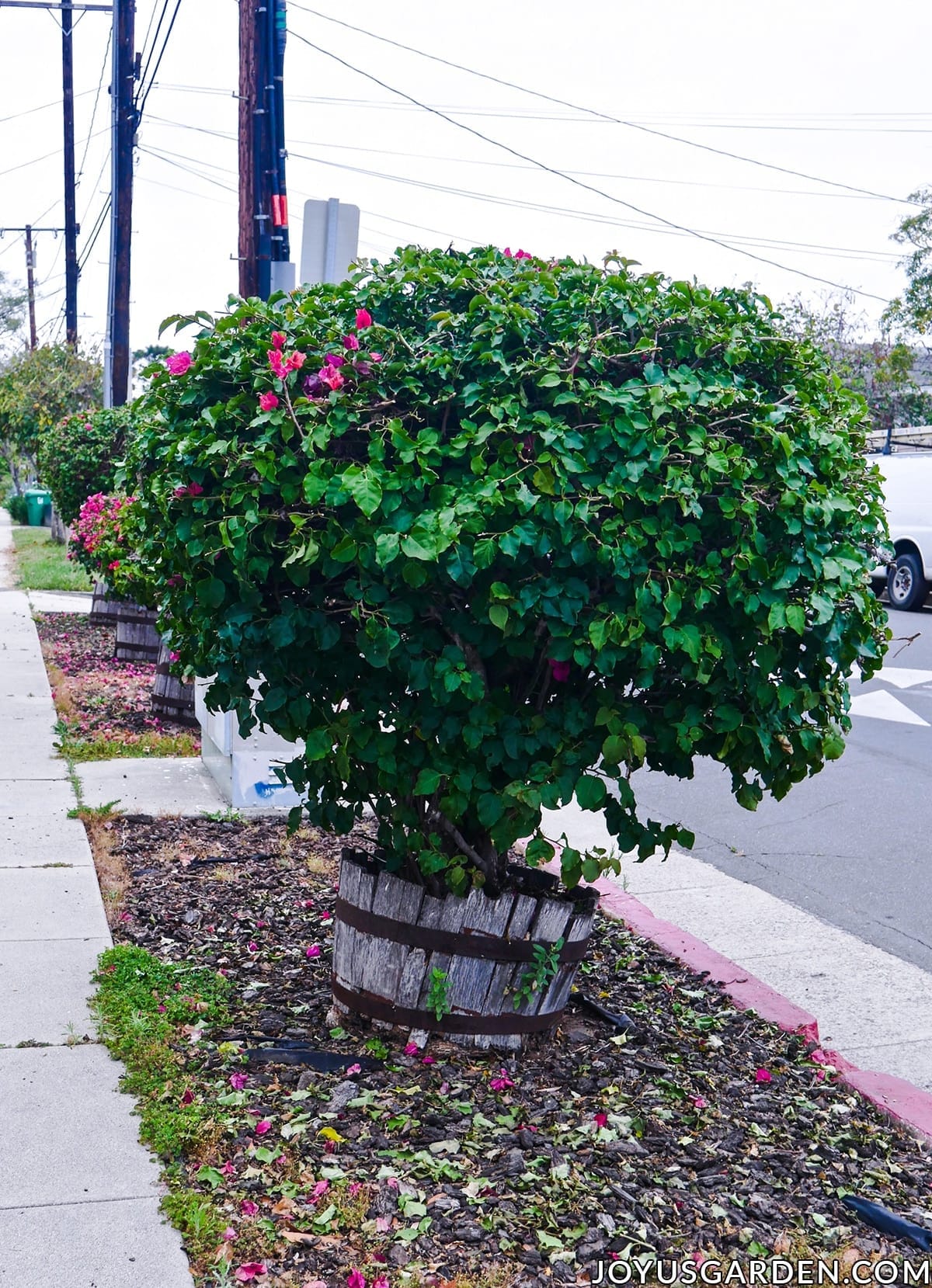
Bougainvillea Repotting / Planting / Soil
I’ve done a dedicated post and video on Planting Bougainvillea In Pots, including the soil mix I use, the steps I took, and one important thing to know, which I’d recommend checking out for all the details.
A few important points I’ll touch on here. The best time to repot or plant is spring through early fall months. Use good quality potting soil with amendments mixed in to ensure richness and good drainage.
I’ll tell you that repotting is a crapshoot. Bougainvilleas don’t like to have their roots disturbed. I’ve never repotted one and can’t recommend it. If you try, be sure to do it in the warmer months.
If you try repotting yours, just be as careful as possible not to injure those sensitive roots. It might be a more successful process if you initially left it in the grow pot. You might be better off just buying a new plant.
Pruning Bougainvillea In Pots
Regular pruning is essential to bougainvillea care in pots, just as it is for those growing in the garden. The extent of the pruning you have to do depends on the size of the bougainvillea you have and the shape you want it to take.
I give mine their big pruning in late winter or early spring – this sets the tone for how I want them to grow and look throughout the season. I’ll do two or three lighter prunes after each bloom cycle.
It’s good to know that bougainvillea blooms on new growth. You want to pinch and prune bougainvillea to bring on the flowering. I sometimes do this for a more concentrated show of color: pinching the tender tips of the branches about to bloom. This makes the show of color denser and not all at the ends.
A word of warning: all bougainvilleas I’ve come across have thorns, so use caution when pruning. If you’re not careful, you can come out from a round of pruning looking like you’ve been in the lion cage!
I’ve done this round-up post on Pruning Bougainvillea, which you’ll find helpful.
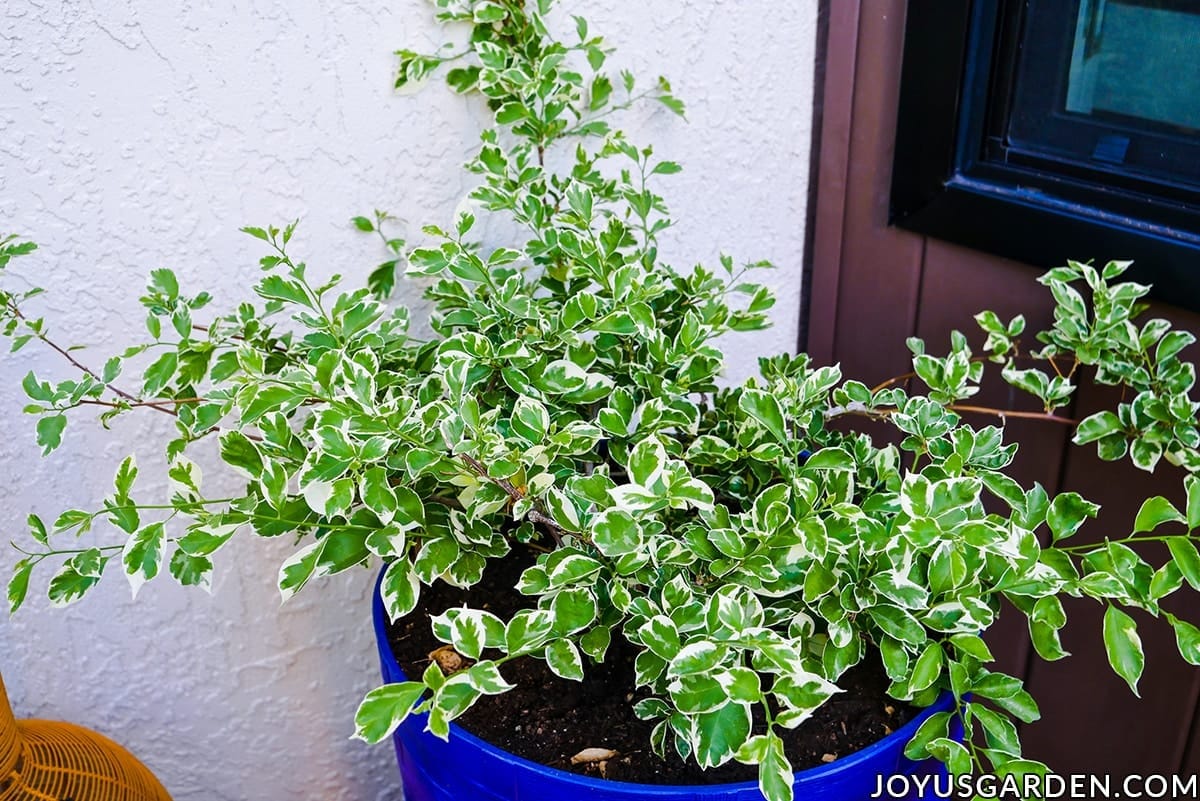
Training/Support For Potted Bougainvillea
This depends on the size of your plant. My Blueberry Ice stays small, so training and support weren’t necessary, just a bit of pruning.
If you have one of the larger growing varieties, you’ll need a metal trellis or some support system for training it to grow up and/or along a wall or fence, over an arbor, or across a structure.
Flowering
As I pointed out in Sun Requirements, bougainvilleas need at least six hours of sun to put on a good show of flowers. More sun = more blooms.
These flowering machines will bloom year-round in warm climates. Where the winters are cool (like here in Tucson), they’ll bloom for around eight months. In Santa Barbara, it was more like nine months.
The small white centers are the flowers, and the colorful, vibrant bracts (the colored leaves) give us those big spectacles of color. Bougainvilleas put out a big floral show, drop their colored bracts, set buds, and then flower again. The color comes in waves, usually 2 – 4 times a year.
I’ve found that some varieties bloom more than others. My Barbara Karst seems the most consistent and steady bloomer of my four bougainvillea varieties.
You can buy bougainvilleas in white, yellow, gold, pink, magenta, to reddish-purple. Some have 2-toned colors and variegated foliage too. There’s something for everyone; except you, lovers of blue. If you want bright colors, this is your plant!
The color of bougainvillea can change a bit after you plant it. This has to do with breeding. Also, bougainvilleas will change color as the seasons change and cooler temperatures set in.
In the colder months, the color is more intense. My bougainvilleas all have deeper-colored flowers in late fall, winter, and spring, but the color becomes less intense when it gets hot.
This is specific to the variety, but my “Rainbow Gold” has newer orange flowers, and then they fade to pink.
Potted Bougainvillea Winter Care
There’s not much I do to my bougainvillea in cold weather because it doesn’t need it. In late winter to early spring, I’ll start the pruning. If necessary, I’ll apply compost around this time too.
More on Bougainvillea Care In Winter here.
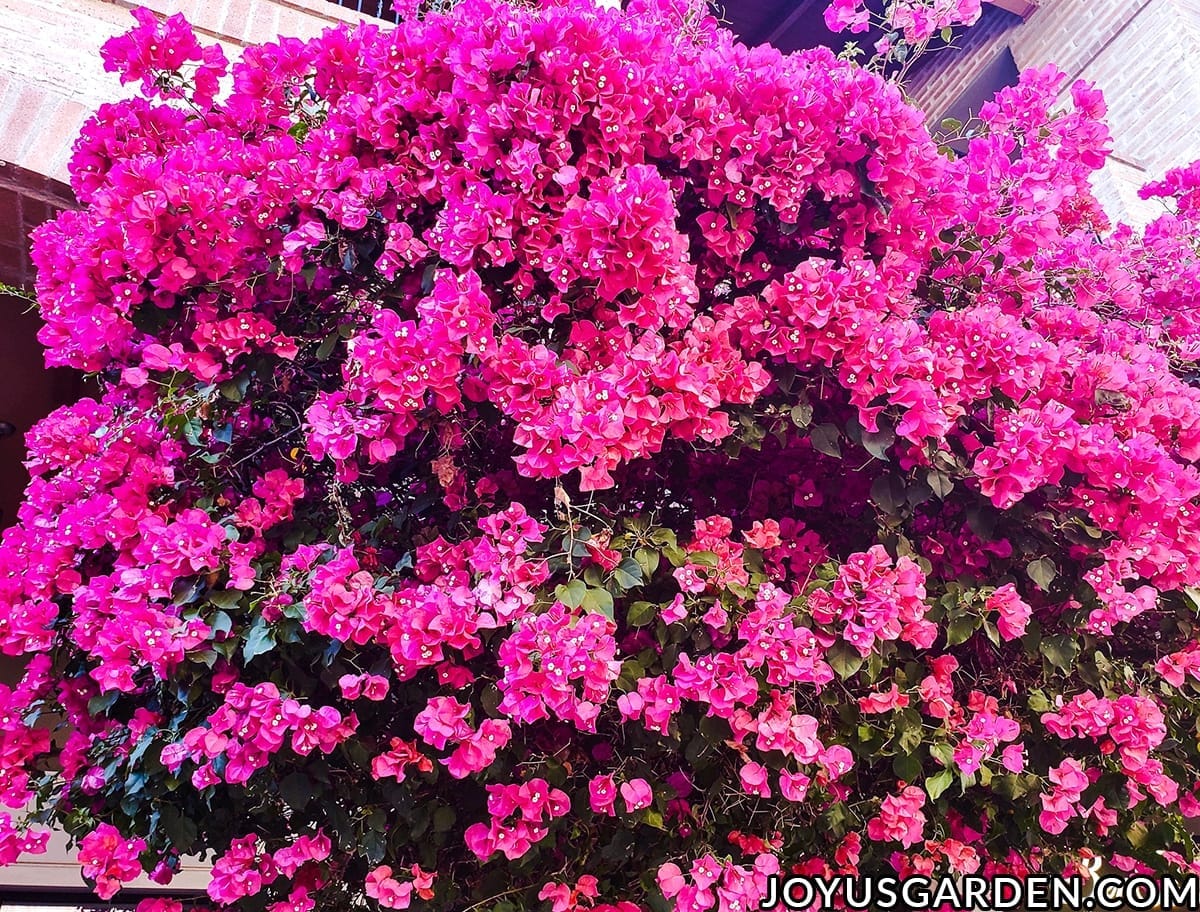
Dwarf Varieties Of Bougainvillea Suited To Growing In Pots
These are the bougainvillea varieties that I’m familiar with that stay under 5′ tall. Some will spread wider than they grow tall. Their smaller size makes them a good choice because care will be easier, and you won’t need a ginormous pot.
Saying dwarf might be pushing it. These compact varieties of bougainvillea are particularly suited for a small garden or small space patio.
- Blueberry Ice (this is the one I have; 3′ x 6′)
- Raspberry Ice (3′ x 6′)
- Golden Jackpot (2′ x 5+’)
- Rosenka (4′ x 6′)
- La Jolla (5′ x 5′)
- Bambino (4′ x 4′)
- Torch glow (4′ x 5′)
- Helen Johnson (3′ x 3′)
These are two buying tips: consider the size the plant gets (the tag should tell you, ask a salesperson or look it up online) and the size of the pot it’s going into. Bougainvilleas come in many sizes. Some reach 1-1/2′ tall, and others get 25′ tall.
Those bigger bougainvilleas will need bigger pots to grow into and do well. Plus, you want a proportionately sized combo for aesthetic reasons.
Monrovia has a good selection of bougainvillea you can peruse.
Bougainvillea In Pots Video Guide
That’s a wrap-up on bougainvillea care in pots. So, the answer to the question I often get: “Does bougainvillea grow well in pots?” is, yes, with proper care!
If you want lower maintenance, I’d choose one of the low-growing varieties listed above. This way, less watering will be required, and less pruning and training means more time to lay in the hammock and enjoy your garden!
Note: This post was originally published on 6/6/2020. It was updated on 4/27/2023.
Happy gardening,

This post may contain affiliate links, you can read our policies here.
- About the Author
- Latest Posts
Nell, the founder of Joy Us garden, was born into a gardening family and grew up in Connecticut’s countryside. After living in Boston, New York, San Francisco, & Santa Barbara, she now calls the Arizona desert home. She studied horticulture & garden design, working in the field all her life. Nell is a gardener, designer, blogger, Youtube creator, & author. She’s been gardening for a very long time & wants to share what she’s learned with you.


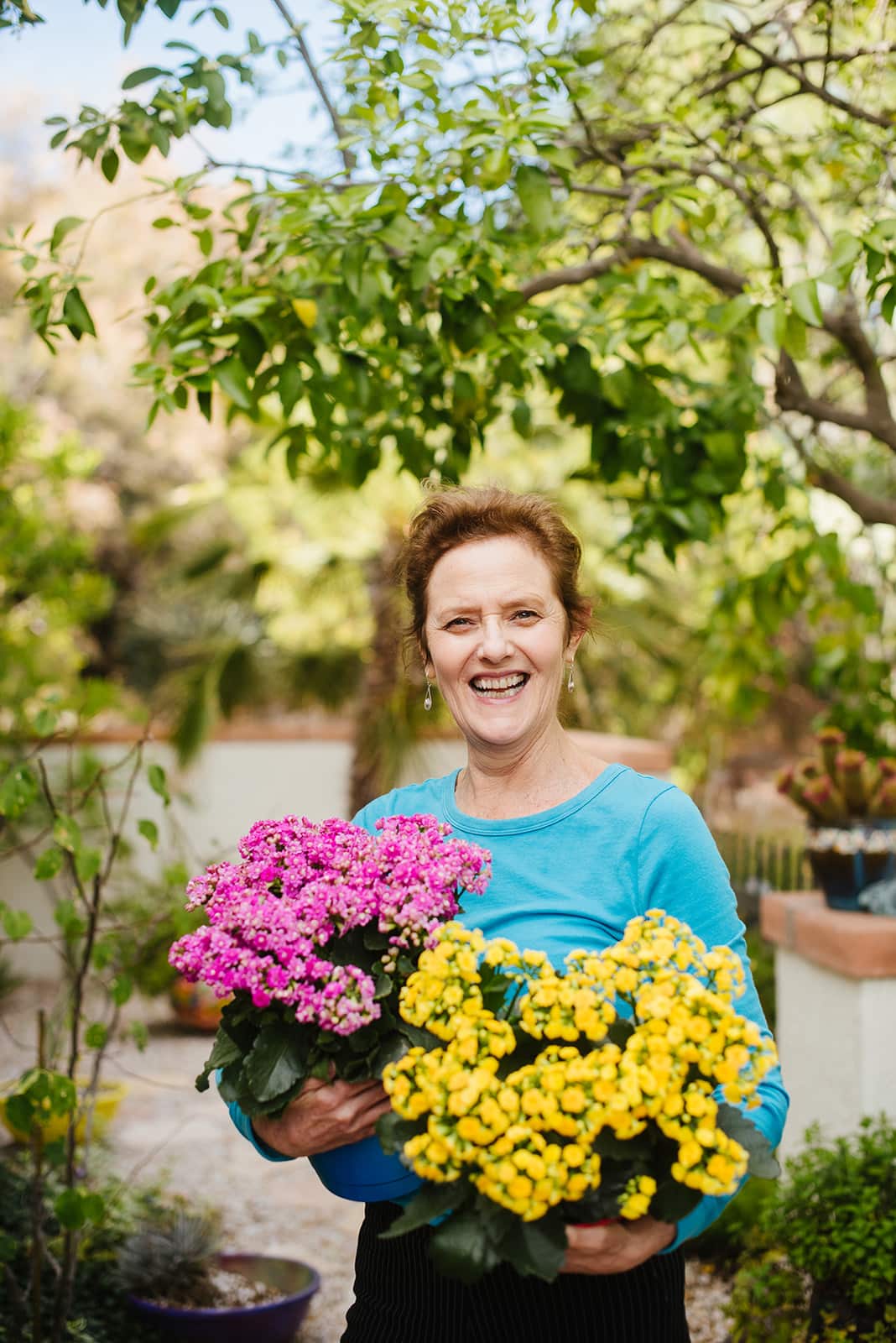
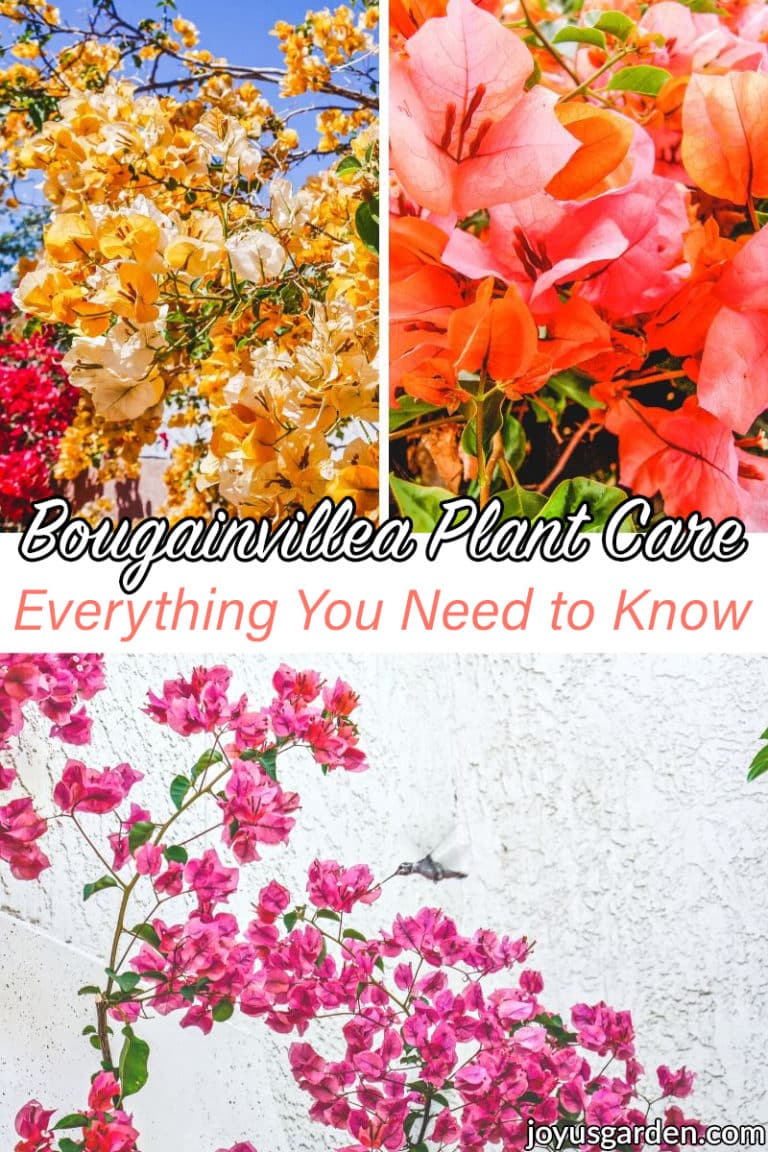
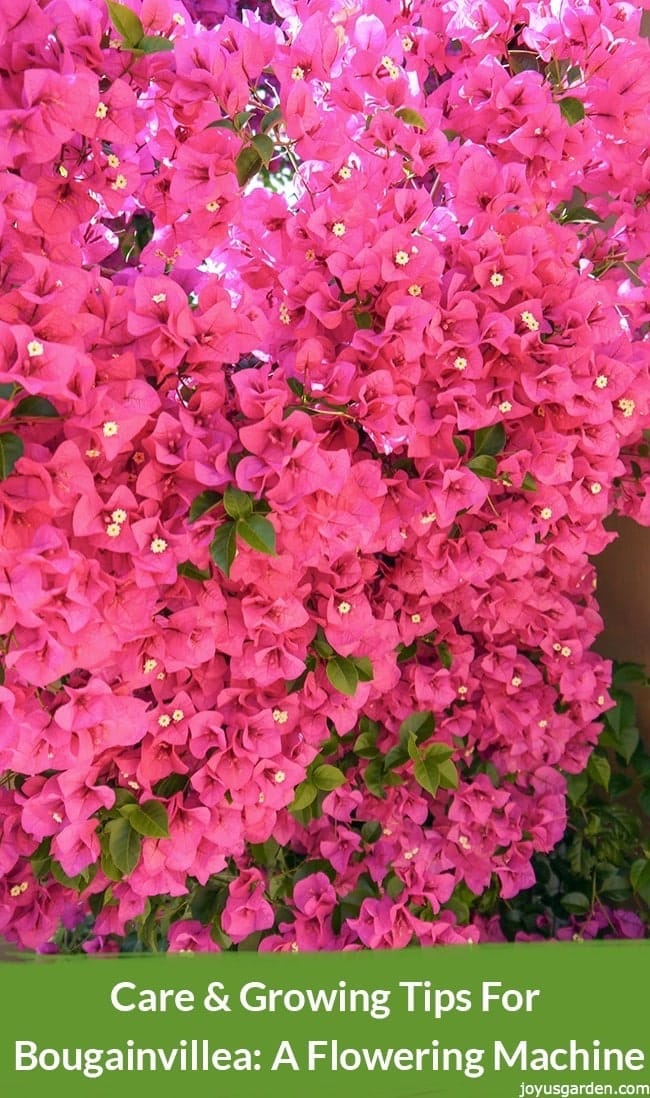
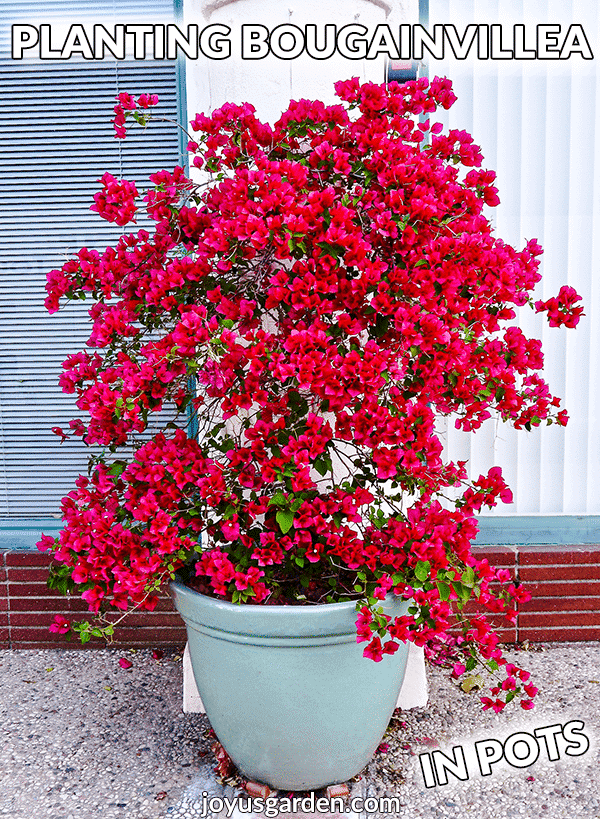
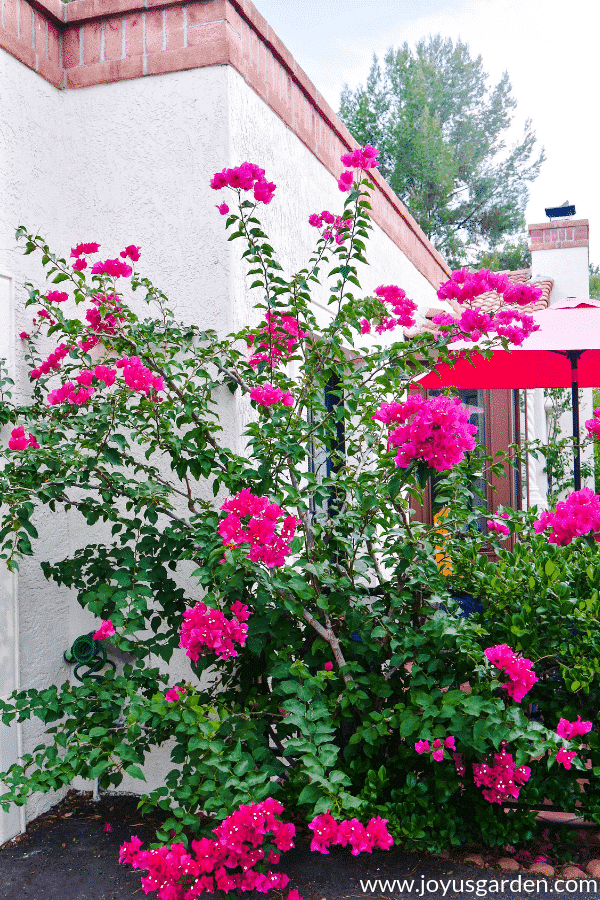

Hi! I am very into your blog, especially when it relates to the Bougs! Thank you for all of your detailed knowledge! I love it!
My question for you is: I have a new Boug and I have just followed your planting in pots blog. My Boug is currently thriving in the mornings when it is in partial shade, but when it enters FULL sun – the leaves start to wilt?
I am not over watering, and I don’t believe that I am underwatering, but I am DYING for it to thrive!
Hope to hear back soon!
Sincerely,
Shelbi
Hi Shelbi – You’re welcome! I don’t know where you live. It could just be a reaction to the heat. If you’re in a hot climate like mine, it happens. It’s 3 in the afternoon, the temp is 102F & there’s a bit of droop going on with my 4 larger bougies. They perk up when the sun is off them. If you left it in the pot, & it’s not a heat issue, then it’s a watering issue. Nell
Wonderful information. I live in the south west tip of Turkey (Datca) with Mediterranean climate. At present I have three full size begoinvilles; purpe, red and orange in my not so big garden. The purple is in a pot. I am now trying to train two more in bonzai style and definitely need any information I can get if you could drop me a note and spare your advice. Thank you ever so much……..
Hi – I trained 1 of my bougainvilleas (when I lived in California) into an umbrella shape. It takes a bit of work to do & maintain but I liked the look. Nell
Hello Nel,
I love your blog and helpful videos. I just purchase a 6ft Bougenvilla that is staked in a 15gal pot. I’m wondering if it will damage the rootball if I remove the stake?? I’d like to attach the plant to the side of my house without the stake.. I’m planing on using your method of slitting sides and burying the container in a very large planter I purchased. Hoping I can pull the stake out?? Thank you in advance!
Monique – I planted bougies both ways (stake in & out). It’s been fine both ways. Nell